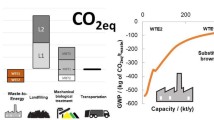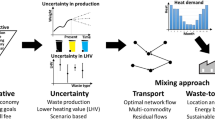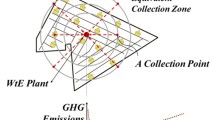Abstract
Landfilling is still the most common way of municipal waste treatment in around half of the EU countries. It has been shown that diverting some of the waste-to-energy recovery makes it possible to reduce emissions of various pollutants, especially when the waste replaces lower-quality fossil fuels in heating plants. A methodology is presented to determine the influence of a waste-to-energy plant with a processing capacity in the range of 10 to 150 kt/y integrated into an existing district heating system on the air pollution load in the surrounding area. The change in emission production is determined using an optimisation tool previously developed in the GAMS environment. The parameters of the existing heating plant, such as the fuels used, the boiler output range, etc., are considered. A Gaussian scatter model is then used to determine the immission loads of individual pollutants in the surrounding area. Using the methodology, it is possible to directly quantify the impact of waste-to-energy plant integration on the health burden of the surrounding population in comparison with the reference state. This strategy is presented via a case study involving real-world data, in which it turned out that the immission load can be significantly reduced (up to 83%) compared to the original state in the calculation scenario.
Graphical abstract





Similar content being viewed by others
Data availability
The datasets generated during the current study are not publicly available due to the large amount of data and their interpretation but are available from the corresponding author on reasonable request.
Abbreviations
- CAQI:
-
Common air quality index (−)
- CHPP:
-
Combined heat-and-power plant
- CU:
-
Cogeneration unit
- DALY:
-
Disability-adjusted life years (y)
- DHS:
-
District heating system
- EIFs:
-
Environmental impact factors
- HTP:
-
Human toxicity potential (1,4-dichlorobenzene equivalents/kg emission)
- i:
-
Number of considered substances
- IL index:
-
Index of immission load (−)
- LCA:
-
Life cycle assessment
- LHV:
-
Lower heating value (MJ/kg)
- li :
-
Immission load index value of the i-th substance (µg/m−3)
- MSW:
-
Municipal solid waste
- ni :
-
Immission concentration of the i-th pollutant (µg/m−3)
- PM10 :
-
Particulate matter of size less than 10 μm diameter
- WtE:
-
Waste-to-energy
- WtEP:
-
Waste-to-energy plant
References
Abdallah M, Hamdan S, Shabib A (2021) A multi-objective optimization model for strategic waste management master plans. J Clean Prod 284:124714. https://doi.org/10.1016/j.jclepro.2020.124714
Air Quality Now (2007) Indices definition, Air quality in Europe. AQN. http://www.airqualitynow.eu/about_indices_definition.php. Accessed 3 March 2020
Al-Hemoud A, Gasana J, Al-Dabbous AN, Al-Shatti A, Al-Khayat A (2018) Disability adjusted life years (DALYs) in terms of years of life lost (YLL) due to premature adult mortalities and postneonatal infant mortalities attributed to PM2.5 and PM10 exposures in Kuwait. Int J Environ Res Public Health 15(11):2609. https://doi.org/10.3390/ijerph15112609
Astrup T, Møller J, Fruergaard T (2009) Incineration and co-combustion of waste: accounting of greenhouse gases and global warming contributions. Waste Manage Res 27:789–799. https://doi.org/10.1177/0734242X09343774
Braniš M (2009) Atmosféra a klima: aktuální otázky ochrany ovzduší (Atmosphere and climate: current issues of air protection), vol 1. Charles University, Prague, Czech Republic (In Czech)
Colls J (2002) Air Pollution, Measurement, Modelling and Mitigation, 2nd edn. CRC Press, London, UK
De Visscher A (2014) Air dispersion modeling: foundations and applications. John Wiley & Sons, Hoboken, New Jersey
Fachinger F, Drewnick F, Gieré R, Borrmann S (2018) Communal biofuel burning for district heating: emissions and immissions from medium-sized (0.4 and 1.5 MW) facilities. Atmos Environ 181:177–185. https://doi.org/10.1016/j.atmosenv.2018.03.014
Fan YV, Varbanov PS, Klemeš JJ, Nemet A (2018) Process efficiency optimisation and integration for cleaner production. J Clean Prod 174:177–183. https://doi.org/10.1016/j.jclepro.2017.10.325
Guo Y, Zhu L, Wang X et al (2022) Assessing environmental impact of NOX and SO2 emissions in textiles production with chemical footprint. Sci Total Environ 831:154961. https://doi.org/10.1016/j.scitotenv.2022.154961
He J, Lin B (2019) Assessment of waste incineration power with considerations of subsidies and emissions in China. Energy Policy 126:190–199. https://doi.org/10.1016/j.enpol.2018.11.025
Huang D, Du Y, Xu Q, Ko JH (2022) Quantification and control of gaseous emissions from solid waste landfill surfaces. J Environ Manage 302:114001. https://doi.org/10.1016/j.jenvman.2021.114001
Huijbregts M A J, Steinmann Z J N, Elshout P M F, Stam G, Verones F, Vieira M D M, Hollander A, Zijp M, van Zelm R (2016) A harmonized life cycle impact assessment method at midpoint and endpoint level, Report I: Characterization
IDEA-ENVI (2019) SYMOS’97. https://www.idea-envi.cz/symos-97.html. Accessed 15 March 2021
Czech Hydrometeorological Institute (Český hydrometeorologický ústav) (2019) Zdroje znečišťování za rok 2017 (Sources of pollution in 2017). https://www.chmi.cz/files/portal/docs/uoco/oez/emise_CZ.html. Accessed 3 February 2021
Czech Hydrometeorological Institute (Český hydrometeorologický ústav) (2021) Průměrné koncentrace za roky 2015–2019 (Average concentrations for the years 2015–2019). ČHMÚ. https://www.chmi.cz/files/portal/docs/uoco/isko/ozko/19petileti/png/index_CZ.html. Accessed 13 February 2021
Istrate IR, Iribarren D, Gálvez-Martos JL, Dufour J (2020) Review of life-cycle environmental consequences of waste-to-energy solutions on the municipal solid waste management system. Resour Conserv Recycl 157:104778. https://doi.org/10.1016/j.resconrec.2020.104778
Janošťák F, Putna O, Pavlas M (2019) Energy dispatch model for integrated waste-to-energy plant. Chem Eng Trans 76:1435–1440. https://doi.org/10.3303/CET1976240
Liu J, Luo X, Yao S et al (2020) Influence of flue gas recirculation on the performance of incinerator-waste heat boiler and NOx emission in a 500 t/d waste-to-energy plant. Waste Manage 105:450–456. https://doi.org/10.1016/j.wasman.2020.02.040
Lu GY, Wong DW (2008) An adaptive inverse-distance weighting spatial interpolation technique. Comput Geosci 34:1044–1055. https://doi.org/10.1016/j.cageo.2007.07.010
Manisalidis I, Stavropoulou E, Stavropoulos A, Bezirtzoglou E (2020) Environmental and health impacts of air pollution: a review. Front Public Health 8:14. https://doi.org/10.3389/fpubh.2020.00014
Mari M, Rovira J, Sánchez-Soberón F, Nadal M, Schuhmacher M, Domingo JL (2018) Partial replacement of fossil fuels in a cement plant: assessment of human health risks by metals, metalloids and PCDD/Fs. Environ Res 167:191–197. https://doi.org/10.1016/j.envres.2018.07.014
Matak N, Tomić T, Schneider DR, Krajačić G (2021) Integration of WtE and district cooling in existing gas-CHP based district heating system – Central European city perspective. Smart Energy 4:100043. https://doi.org/10.1016/j.segy.2021.100043
McKone TE, Hertwich EG (2001) The human toxicity potential and a strategy for evaluating model performance in life cycle impact assessment. Int J Life Cycle Assess 6:106–109. https://doi.org/10.1007/BF02977846
Nami H, Arabkoohsar A, Anvari-Moghaddam A (2019) Thermodynamic and sustainability analysis of a municipal waste-driven combined cooling, heating and power (CCHP) plant. Energy Convers Manage 201:112158. https://doi.org/10.1016/j.enconman.2019.112158
Nevrlý V, Šomplák R, Gregor J, Pavlas M, Klemeš JJ (2018) Impact assessment of pollutants from waste-related operations as a feature of holistic logistic tool. J Environ Manage 220:77–86. https://doi.org/10.1016/j.jenvman.2018.05.003
Nevrlý V, Šomplák R, Putna O, Pavlas M (2019) Location of mixed municipal waste treatment facilities: cost of reducing greenhouse gas emissions. J Clean Prod 239:118003. https://doi.org/10.1016/j.jclepro.2019.118003
Owusu PA, Sarkodie SA (2020) Global estimation of mortality, disability-adjusted life years and welfare cost from exposure to ambient air pollution. Sci Total Environ 742:140636. https://doi.org/10.1016/j.scitotenv.2020.140636
Panagopoulos A (2022) Study and evaluation of the characteristics of saline wastewater (brine) produced by desalination and industrial plants. Environ Sci Pollut Res 29:23736–23749. https://doi.org/10.1007/s11356-021-17694-x
Popovic T, Kraslawski A (2015) Chapter 24 - Social Sustainability of Complex Systems. In: You F (ed) Computer Aided Chemical Engineering. Elsevier, pp 605–614
Putna O, Janošťák F, Pavlas M (2018a) Modelling of existing heating plant replacement with a waste to energy plant and a peak-load natural gas boiler. Chem Eng Trans 70:1615–1620. https://doi.org/10.3303/CET1870270
Putna O, Janošťák F, Šomplák R, Pavlas M (2018b) Demand modelling in district heating systems within the conceptual design of a waste-to-energy plant. Energy 163:1125–1139. https://doi.org/10.1016/j.energy.2018.08.059
Putna O, Janošťák F, Pavlas M (2020) Greenhouse gas credits from integrated waste-to-energy plant. J Clean Prod 270:122408. https://doi.org/10.1016/j.jclepro.2020.122408
Reimann D O (2012) CEWEP Energy report III, results of specific data for energy, R1 plant efficiency factor and NCV of 314 European waste-to-energy (WtE) plants. Bamberg, Germany: CEWEP, Confed Eur Waste-to-Energy Plants
Saharidis GKD, Konstantzos GE (2018) Critical overview of emission calculation models in order to evaluate their potential use in estimation of greenhouse gas emissions from in port truck operations. J Clean Prod 185:1024–1031. https://doi.org/10.1016/j.jclepro.2018.02.036
Santin M, Chinese D, De Angelis A, Biberacher M (2020) Feasibility limits of using low-grade industrial waste heat in symbiotic district heating and cooling networks. Clean Techn Environ Policy 22:1339–1357. https://doi.org/10.1007/s10098-020-01875-2
Sauve G, Van Acker K (2020) The environmental impacts of municipal solid waste landfills in Europe: a life cycle assessment of proper reference cases to support decision making. J Environ Manage 261:110216. https://doi.org/10.1016/j.jenvman.2020.110216
Schauberger G, Piringer M, Knauder W, Petz E (2011) Odour emissions from a waste treatment plant using an inverse dispersion technique. Atmos Environ 45:1639–1647. https://doi.org/10.1016/j.atmosenv.2011.01.007
The European IPPC Bureau (2019) Reference document on the best available techniques for waste incineration. https://eippcb.jrc.ec.europa.eu/sites/default/files/2020-01/JRC118637_WI_Bref_2019_published_0.pdf. Accessed 16 December 2021
Turner DB (1994) Workbook of atmospheric dispersion estimates: an introduction to dispersion modeling, 2nd edn. Lewis Publishers, Boca Raton
United States environmental protection agency (EPA) (2016) AP-42: compilation of air emissions factors. air emissions factors and quantification. https://www.epa.gov/air-emissions-factors-and-quantification/ap-42-compilation-air-emissions-factors. Accessed 8 December 2021
Van Caneghem J, Van Acker K, De Greef J et al (2019) Waste-to-energy is compatible and complementary with recycling in the circular economy. Clean Techn Environ Policy 21:925–939. https://doi.org/10.1007/s10098-019-01686-0
Woon KS, Lo IMC (2013) Greenhouse gas accounting of the proposed landfill extension and advanced incineration facility for municipal solid waste management in Hong Kong. Sci Total Environ 458–460:499–507. https://doi.org/10.1016/j.scitotenv.2013.04.061
World Health Organization (WHO) (2018) factsheet no. 313: ambient (outdoor) air quality and health. https://www.who.int/news-room/fact-sheets/detail/ambient-(outdoor)-air-quality-and-health. Accessed 25 March 2021
World Health Organization (2021) WHO global air quality guidelines: particulate matter (PM2.5 and PM10), ozone, nitrogen dioxide, sulfur dioxide and carbon monoxide. WHO. https://apps.who.int/iris/handle/10665/345329. Accessed 1 December 2021
Zhou Y, Wei Z, Sun G, Cheung KW, Zang H, Chen S (2018) A robust optimization approach for integrated community energy system in energy and ancillary service markets. Energy 148:1–15. https://doi.org/10.1016/j.energy.2018.01.078
Funding
The research was funded by the project Sustainable Process Integration Laboratory – SPIL, funded as project No. CZ.02.1.01/0.0/0.0/15_003/0000456, by Czech Republic Operational Programme Research and by the Technology Agency of the Czech Republic (TACR) within the research project National Centres of Competence, specifically through the project National Centre for Energy (TN1000007).
Author information
Authors and Affiliations
Corresponding author
Ethics declarations
Conflict of interest
The authors have no relevant financial or non-financial interests to disclose.
Additional information
Publisher's Note
Springer Nature remains neutral with regard to jurisdictional claims in published maps and institutional affiliations.
Rights and permissions
About this article
Cite this article
Putna, O., Pavlas, M., Turek, V. et al. Influence of waste-to-energy plant integration on local immission load. Clean Techn Environ Policy 24, 3047–3059 (2022). https://doi.org/10.1007/s10098-022-02344-8
Received:
Accepted:
Published:
Issue Date:
DOI: https://doi.org/10.1007/s10098-022-02344-8




